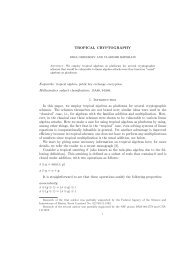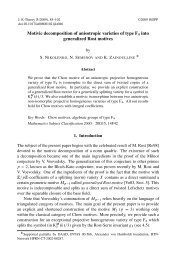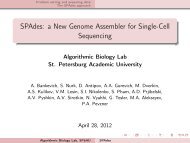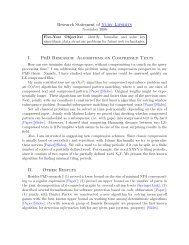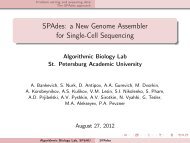Word Equations, Fibonacci Numbers, and Hilbert's Tenth Problem
Word Equations, Fibonacci Numbers, and Hilbert's Tenth Problem
Word Equations, Fibonacci Numbers, and Hilbert's Tenth Problem
You also want an ePaper? Increase the reach of your titles
YUMPU automatically turns print PDFs into web optimized ePapers that Google loves.
<strong>Word</strong> <strong>Equations</strong>, <strong>Fibonacci</strong> <strong>Numbers</strong>, <strong>and</strong>Hilbert’s <strong>Tenth</strong> <strong>Problem</strong>Yuri MatiyasevichSteklov Institute of Mathematics at Saint-Petersburg27 Fontanka, Saint-Petersburg, 191023, RussiaURL: http://logic.pdmi.ras.ru/~yumatIn his tenth problem D. Hilbert [1] asked for an algorithm for decidingwhether an arbitrary Diophantine equation has a solution in integers. Asa possible way to establish the undecidability of Hilbert’s tenth problemA.A.Markov suggested to prove the undecidability of word equations. Anysuch equation (w.l.o.g, in the two-letter alphabet B = {0, 1}) can be easilyreduced to a Diophantine equation using the fact that every 2 × 2 matrixwith natural number elements <strong>and</strong> the determinant equal to zero can berepresented in a unique way as the product of matrices B 0 = ( )1 01 1 <strong>and</strong>B 1 = ( )1 10 1 . This allows us to treat a quadruple of non-negative integers〈a 11 , a 12 , a 21 , a 22 〉 such that a 11 a 22 − a 21 a 12 = 1 as a word in the alphabet B,the concatenation being just matrix multiplication.This approach to Hilbert’s tenth problem turned out to be fruitless:G. S. Makanin [2] found a decision procedure for word equations. Nevertheless,we could try to revive Markov’s idea by considering a wider class ofword equations.Every word X = χ n χ n−1 . . . χ 1 in the alphabet B can be viewed as thenumberx = χ n u n + χ n−1 u n−1 + · · · + χ 1 u 1 (1)written in positional system with weights of digits being the <strong>Fibonacci</strong> numbersu 1 = 1, u 2 = 1, u 3 = 2, u 4 = 3, u 5 = 5, . . . (rather than traditional 1, 2,4, 8, 16, . . . ). According to Zeckendorf’s theorem, every natural number xcan be represented in the form (4) with additional restrictions χ i+1 χ i = 0<strong>and</strong> χ 1 = 0, <strong>and</strong> in unique way.1
Every word α in α in−1 . . . α i1 in the infinite alphabet A = {α 1 , α 2 , . . . } canbe presented as a word in the alphabet B10 i m10 i m−1. . . 10 i 1(2)satisfying the restrictions of Zeckendorf’s theorem. Thus we get, via <strong>Fibonacci</strong>numbers, a natural one-to-one correspondence between words in theinfinite alphabet A <strong>and</strong> natural numbers, the kth word under this enumerationwill be denoted Z k .Now in order to be able to transform an arbitrary word equation into anequivalent Diophantine equation we need only to express the concatenationrelation Z k = Z k1 Z k2 by Diophantine equation(s). For this goal it is moreconvenient to code a word X by a quadruple 〈v, w, x, y〉 where x is as in (1),<strong>and</strong>v = u n , w = u n−1 , y = χ n u n−1 + χ n−1 u n−2 + · · · + χ 1 u 0 . (3)Thanks to the equality φ m = φu m + u m−1 where φ is the golden ratio 1+√ 52,the numberφx + y = χ n φ n + χ n−1 φ n−1 + · · · + χ 1 φ (4)is represented by the word X in the positional system with weights of digitsbeing powers of the golden ratio 1, φ, φ 2 , φ 3 , . . . Now the relation Z 〈v,w,x,y〉 =Z 〈v1 ,w 1 ,x 1 ,y 1 〉Z 〈v2 ,w 2 ,x 2 ,y 2 〉 is just the equalityφx + y = (φx 1 + y 1 )(φv 2 + w 2 ) + φx 2 + y 2 . (5)It still remains to distinguish those quadruples 〈v, w, x, y〉 which are codesof words. It is not difficult to check that numbers defined by (1) <strong>and</strong> (3)satisfy the following conditions:(w 2 + vw − v 2 ) 2 = 1, (6)v ≤ x < v + w, (7)φ − 2 < y − x/φ < φ − 1. (8)On the other h<strong>and</strong>, according to an old theorem of Wasteels [5] solutions ofthe equation (6) are exactly consecutive <strong>Fibonacci</strong> numbers. Thus for a fixedvalue of x, conditions (6)–(8) uniquely determine the values of v, w, <strong>and</strong> y.Conditions (5)–(8) can be easily transformed into desired Diophantineequations.2
Now we are capable to transform into Diophantine equations not onlyword equations but a broader class of conditions on words. In particular,condition v 1 = v 2 expresses the equality of the lengths of words Z 〈v1 ,w 1 ,x 1 ,y 1 〉<strong>and</strong> Z 〈v2 ,w 2 ,x 2 ,y 2 〉.Open question. Is there an algorithm for deciding whether an arbitrarysystem of word equations <strong>and</strong> equalities of length of words has a solution?As we have seen, the undecidability of this problem would give a proofof the undecidability of Hilbert’s tenth problem very different from knowntoday (see, for example, [4]).In the above arithmetization of words we had the restriction that a wordcannot contain “11” <strong>and</strong> cannot end by “1”. This drawback can be easilyeliminated by the following modifications. Having an arbitrary word in thealphabet B, we at first transform it into a “restricted” word by replacing each“1” by“10” <strong>and</strong> each “0” by “00”; formally, representation (1) is replaced byCondition (6) is strengthened tox = χ n u 2n + χ n−1 u 2(n−1) + · · · + χ 1 u 2 . (9)w 2 + vw − v 2 = 1 (10)to imply that v = u m with even m <strong>and</strong> hence the word Z 〈v,w,x,y〉 has evenlength. In order to pass back from numbers to words we cut Z 〈v,w,x,y〉 intoblocks of length 2 <strong>and</strong> then replace “00” by “0” while both “10” <strong>and</strong> “01”are replaced by “1”. Now instead of one-to-one correspondence betweenwords <strong>and</strong> numbers we have one-to-many correspondence but this isn’t anobstacle for transforming systems of word equations <strong>and</strong> length equalitiesinto equivalent Diophantine equations.Besides equalities of lengths of words, we cam impose conditions in theform “the length of the word Z 〈v1 ,w 1 ,x 1 ,y 1 〉 is divisible by the length of theword Z 〈v2 ,w 2 ,x 2 ,y 2 〉” (see [3]).References[1] David Hilbert, Mathematische <strong>Problem</strong>e. Vortrag, gehalten auf dem internationalenMathematiker Kongress zu Paris 1900, Nachr. K. Ges.3
Wiss., Göttingen, Math.-Phys. Kl. (1900), 253–297. See also DavidHilbert, Gesammelte Abh<strong>and</strong>lungen, Berlin : Springer, vol. 3 (1935),310 (Reprinted: New York : Chelsea (1965)).[2] G. S. Makanin. The problem of solvability of equations in a free semigroup(in Russian). Math. USSR Sbornik, 32(2):129–198, 1977.[3] Matiyasevich Yu. Svyaz’ sistem uravneniĭ v slovakh i dlinakh s 10-ĭ problemoĭ Gil’berta, Zap. nauch. seminar. Leningr. otd. Mat. in-taAN SSSR, 8:132–144, 1968. English translation: The connection betweenHilbert’s <strong>Tenth</strong> <strong>Problem</strong> <strong>and</strong> systems of equations between words<strong>and</strong> lengths. Seminars in Mathematics, V.A.Steklov Mathematical Institute,8:61–67, 1970, available via http://logic.pdmi.ras.ru/~yumat/Journal.[4] Matiyasevich Yu. Desyataya <strong>Problem</strong>a Gilberta (in Russian). Moscow,Fizmatlit, 1993. English translation: Hilbert’s tenth problem. MITPress, 1993. French translation: Le dixième problème de Hilbert,Masson, 1995. Homepage of the book: http://logic.pdmi.ras.ru/~yumat/H10book.[5] M. J. Wasteels. Quelques propriété des nombres de <strong>Fibonacci</strong>. Mathesis,troisième série, tome II, 60-62, 1902.4



